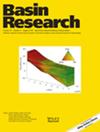Crustal Melting Events During the Late Stage of Syn-Rift at the Magma-Intermediate Continental Margin: A Numerical Study From the Northern South China Sea Margin
Abstract
The traditional distinction of magma-poor and magma-rich margins is challenged by the presence of significant late-stage rift-related magmatism in certain margins, such as the South China Sea (SCS). We use numerical modelling to investigate the conditions and processes that lead to crustal melting and the formation of high-velocity lower crustal layers (HVLs) in such magma-intermediate margins. The models demonstrate that the preferential removal of the lithospheric mantle during rifting is crucial for crustal melting, as it allows the crust to receive sufficient heat from the upwelling asthenosphere. The extent and distribution of crustal melts are influenced by extension velocity and crustal rheology, and the models reveal a strong correlation between the presence of crustal melts and thin-crust domains (< 20 km thick). The study reveals a younger-oceanward trend in magmatism, attributed to the progressive exposure of the crust to the hot asthenosphere during rifting. Comparison of modelling results with seismic observations from the SCS margin suggests that both asthenospheric and crustal melts contribute to the formation of HVLs, with crustal melts estimated to constitute approximately 15%–30%. The results not only deepen our understanding of magmatic processes in magma-intermediate margins, but also provide quantitative evidence for the classification and interpretation of passive margins.



 求助内容:
求助内容: 应助结果提醒方式:
应助结果提醒方式:


